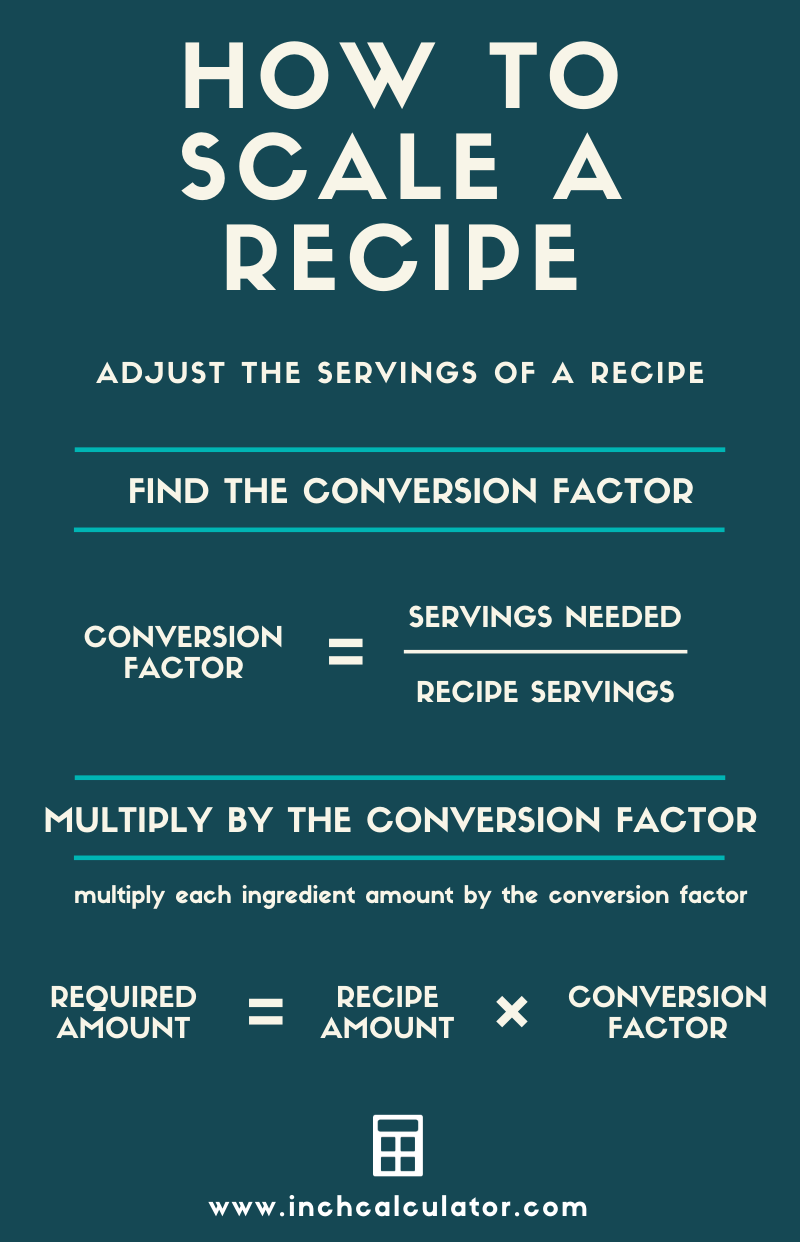Recipe Scale Conversion Calculator – Recipe Multiplier
If you find the process of scaling a recipe up or down confusing or tedious like we do, then you’re going to love this recipe scaling calculator!
Enter your ingredients, and the calculator will increase or decrease them automatically.
Scaled Recipe Ingredients:
On this page:
- Recipe Scale Conversion Calculator
- How to Scale a Recipe
- Step One: Find the Conversion Factor
- Step Two: Adjust the Recipe Using the Conversion Factor
- Step Three: Convert Measurements
- Things to Consider When Scaling a Recipe
- Measuring by Weight vs. Volume
- Cooking and Baking Times May Change
- References
How to Scale a Recipe
If you are a professional chef looking to scale up a recipe for an event or a home cook looking to scale down a family recipe, this calculator will give you a step-by-step process that guarantees accurate results every time.

Step One: Find the Conversion Factor
Firstly, determine if you are scaling up or down in terms of portion size per person. Once you’ve determined portion size, use this formula to find the conversion factor.
conversion factor = portions needed ÷ recipe portions
Industry pros call the number of portions the yield, so the conversion factor here is the required yield divided by the recipe’s yield. Doubling the recipe means the conversion factor is 2, and cutting the recipe in half would be 0.5.[1]
Hint: you can use a tool such as our scale calculator to find the scale factor.
Step Two: Adjust the Recipe Using the Conversion Factor
Using the conversion factor, you can easily adjust the amount of each ingredient in your recipe by multiplying the portion size by the conversion factor.
For example, if the conversion factor is 2 and the recipe calls for 3 tablespoons of an ingredient, the scaled recipe calculation would be 2 × 3 = 6, which equals 6 tablespoons.
Step Three: Convert Measurements
Finally, convert the measurements into their new quantity. This step is optional but greatly simplifies your recipe, and it’s what the real chefs do! If a recipe calls for 4 ounces, but the final adjusted measurement is 16 ounces, then you’d convert that 16 ounces into 1 pound.
When you scale a recipe, the measures used might not be appropriate any longer. If a recipe calls for 4 ounces and the recipe is quadrupled, then the new amount would be 16 ounces. Since there are 16 ounces in a pound, you can convert the ingredient quantity from 16 ounces to 1 pound.
Refer to our cooking conversion calculator or the common list of kitchen conversions below for quick and easy conversions.
| Measurement | Equivalent Measurement |
|---|---|
| 1 tablespoon | 3 teaspoons |
| 1 fluid ounce | 2 tablespoons |
| 1 cup | 8 fluid ounces |
| 1 pint | 2 cups |
| 1 quart | 2 pints |
| 1 gallon | 4 quarts |
| 1 pound | 16 ounces |
Try our volume and weight conversion calculators to simplify converting from a smaller unit to a larger one.
Things to Consider When Scaling a Recipe
Here are some common things to consider when scaling recipes to ensure successful results anytime you want to convert a recipe.
Measuring by Weight vs. Volume
Scaling up in volume increases the inaccuracy of measuring by volume. Converting to weight first decreases the margin of error. See our sugar and flour conversion calculators to convert from volume to weight.
Dry ingredients should be measured by weight rather than volume to improve the accuracy of the recipe. Dry ingredients vary slightly in density and can be compacted differently when measuring.
PRO TIP: Never scoop dry ingredients like flour or powdered sugar directly from the bag with a measuring up as it’s settled and compacted. Use a whisk to aerate dry ingredients before measuring for more accurate results.
Professional chefs and bakers recommend that dry ingredients should be measured by weight instead of volume.[2] Convert to weight before using the calculator above.
PRO TIP: A small digital kitchen scale is a valuable kitchen tool if you bake a lot.
Cooking and Baking Times May Change
Be aware that converting and scaling recipes likely means cooking/baking times and temperatures will require adjusting as well. It’s wise to practice with a recipe or two from start to finish so you can record the new recipe yields and any other cooking or baking notes that arise (pun intended).
References
- The BC Cook Articulation Committee, Basic Kitchen and Food Service Management, https://ecampusontario.pressbooks.pub/basickitchenandfoodservicemanagement/chapter/convert-and-adjust-recipes-and-formulas/
- National Institute of Standards & Technology, Culinary Measurement Tips, https://www.nist.gov/pml/owm/culinary-measurement-tips


